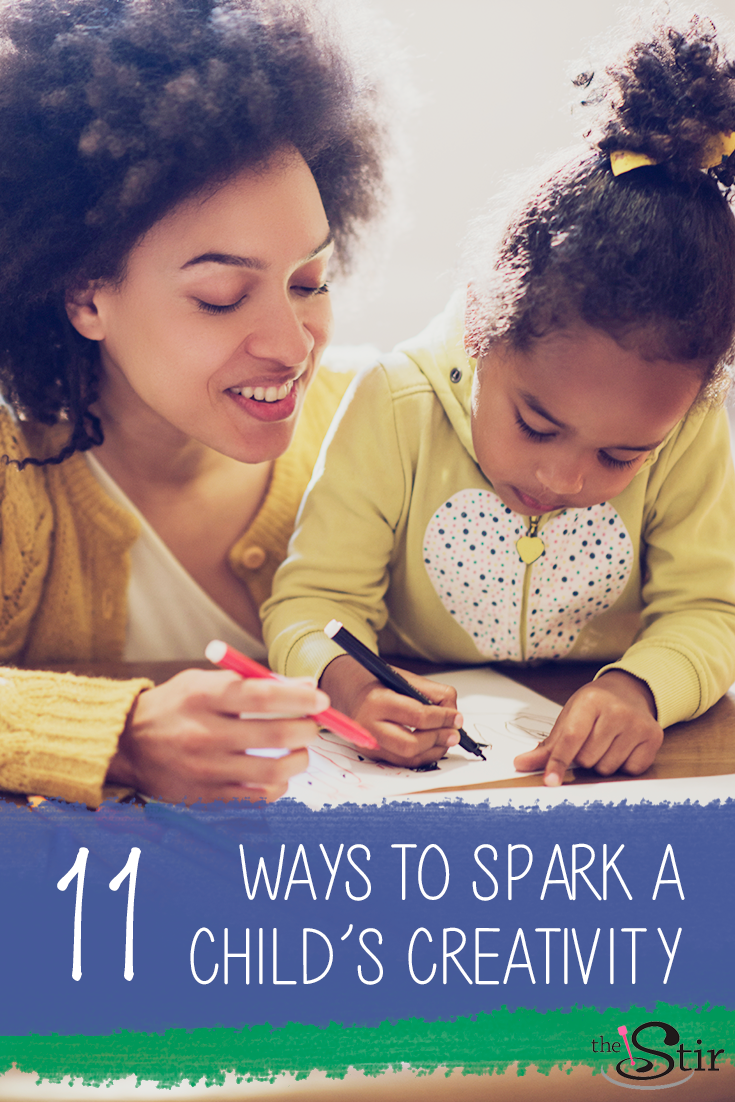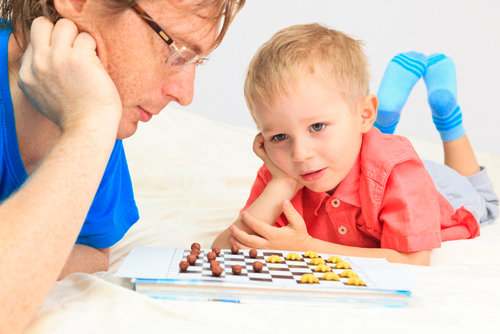

In a day and age when kids can be so easily entertained (a.k.a. zoned out) via tablets, TVs, and other toys, parents may wonder: How do they get their kids to turn on their own imaginations instead?
Don't accept that imaginative play is a dying art form—there are plenty of ways to jump-start kids' creative engines without enrolling them in art class. The secret, in fact, may be as simple as getting out of their way. Check out these tips to foster a more fertile imagination in kids.

Play Dumb

"When you sit down to play with your small being, act confused!" suggests Dr. Marcie Beigel, a teacher and behavior therapist who fosters creativity in kids at home and in class. "Don't start or set up the game for them; ask them to start first. Especially with building or drawing, small beings will often imitate what they see an adult do. If they go first, it is all about their creativity."
Don't Correct What's 'Wrong'

Fine, so your kid made up his own renegade rules for checkers. That's okay, provided he's more into having fun than learning the ropes. "When playing with kids, most parents fall into the trap of encouraging them to complete certain actions that 'make sense,'" says Wendy Krone, spokesperson for Pump It Up, a destination for creative kid parties. "But remember, there's no 'right' way to play! Play is supposed to be fun, limitless and filled with joy. There don't need to be rules in how to play, so just follow the flow and see where your child's imagination goes."
Stick With Simple Toys

Today, so many toys talk, walk, and otherwise act like a surrogate friend; these toys are so complex they leave very little the imagination. "Simpler, abstract toys encourage creativity and fantasy because kids need to connect the dots more," says David Elkind, Ph.D., Professor Emeritus in the Eliot-Pearson Department of Child Development at Tufts University and the author of The Power of Play. Invest some good, old-fashioned blocks, toy cars, no-frills dolls or anything else without batteries that encourages kids to project their own ideas onto the objects they're playing with.
Play 'What If'

Rather than ask the usual question "So how was school?" (boooring!), jump-start their imaginations — and dinnertime conversation! — by asking how they'd react to more fanciful scenarios. "Make up a story in mid-conversation at the dinner table," says Lisa Baker-King, a family coach who helps adults and children cultivate their passions. It can be based on reality ("If you could be teacher one day at school what would you do?") or more out-there ("What would you do if an alien landed in your room one night?").
More from The Stir: 15 Cool Kid Crafts to Use Up Those Extra Toilet Paper Rolls in Your House
Let Kids Make a Mess

One of the cornerstones of imaginative play is the freedom to make a mess — as such, hovering over them stressing over every drop of paint or dirty fingernail will stifle those creative juices. "When kids are being creative, it's their world and they should be allowed to by messy," says Jacqui Blue, a creativity coach. "So if your kids would rather paint with their fingers than a brush, let them go for it. If they want to mix mediums and add earth elements to their painting — why not?" Try to set things up so you don't have to hover or worry — we mean newspapers covering the floor, or set up your art stand outside.
Don't Clean Up Too Soon

While certain messes require clean-up, consider letting other "messes" lie as long as they're not causing any harm. "If possible, postpone cleaning up blocks, LEGOs, dolls and action figures that have been used to create an imaginative scene, such as a race track, pirate ship, or puppy city," says Ann Gadzikowski, author of Creating a Beautiful Mess: Ten Essential Play Experiences for a Joyous Childhood. "Allow children opportunities to re-visit and expand their pretend worlds.
Let Your Kids Get Bored

When your kid whines "I'm booooored," that's a bad thing, right? Wrong. That's exactly when kids' minds tend to wander in surprisingly fruitful directions. "Let your kids get bored, because from boredom comes creativity," says Dr. Marcie. "If we are always giving them suggestions, they have no need to come up with their own ideas."
Let Them Play With Their Food

Kids need to eat — so why not let them flex their imagination in the kitchen? "Make up a recipe with your children and let them know that you are 'making it up,'" suggests Baker-King. Then, treat chow-down time as a chance to analyze by trial and error: "After you eat your creation, talk about what worked and ask them, 'What would you do differently next time?'"
More from The Stir: 10 Fun Kid Crafts That Also Build Reading Skills
Build Your Own Board Game

"Instead of breaking out the board games, have your kids create their own," suggests Karen Kilpatrick, author of the upcoming book Imagine. All you need is a sheet of cardstock or cardboard, some markers, and your imaginations for the rest: How many players are there? What happens when you win? Anything is possible!
Have Them Tell Their Own Stories

We've all read our kids stories … but why not have them make up their own? At bedtime, rather than breaking out a book, announce that you'll come up with the first sentence to a story ("Once upon a time a girl named Jasmine went to the pet store to buy a puppy"). Then challenge your kid to come up with the next sentence that builds off your own, and so on back and forth. You can even write it all down and create your own book with illustrations.
Celebrate All Their Creations

So your kid put five horns on his clay unicorn sculpture, or painted his color-by-numbers picture with all the "wrong" colors. Who cares? It's still beautiful and an opportunity to praise their creativity. "Whatever they imagine is perfect — let them know you are excited about it, even if it's 'wrong,'" says Dr. Marcie. "Too often we want to change or add or correct creativity. Simply celebrate whatever your small being comes up with and play along."
More from The Stir: 12 Science Experiments Kids Can Create at Home







